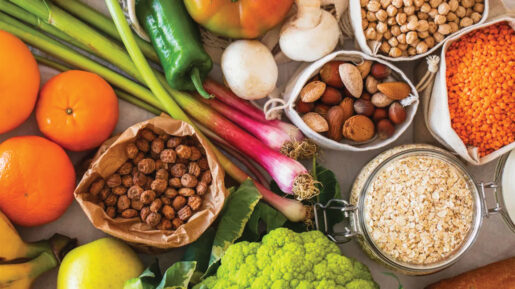By Mohammad Ahrar, PhD
Introduction
Fiber is a kind of carbohydrate found in plants. Unlike some other forms of carbohydrates that are highly digestible in the human body, fiber isn’t digested and passes relatively intact through the gastrointestinal tract and out of the body. So, what is the benefit of fiber?

Dietary Fiber Composition
Dietary fiber is defined as “all plant polysaccharides and lignin which are resistant to hydrolysis by the digestive enzymes of man.” (1) Fibers are technically considered complex carbohydrates or polysaccharides made of chains of simple sugars such as glucose. Fibers are found only in plants and foods of plant origin. Animal food sources do not have fiber.
Plants produce carbohydrates and other nutrients during the process of photosynthesis—carbon from atmospheric carbon dioxide (CO2) and hydrogen from water (H2O), absorbed from the soil, are put together in plant cells using the solar energy to form glucose (with 6 carbon atoms). When several glucose molecules bind together, they form a chain of polysaccharide such as fiber. The major dietary fibers include cellulose, hemicellulose, and pectin. Plant foods can contain all forms of fibers in varying amounts or have more concentration of one type of fiber.
Physiological Properties of Fiber
Depending on the type of chemical bonds between sugar molecules, a variety of carbohydrates are formed. For example, the bonds between glucose molecules in the starch (a polysaccharide) are formed in such a way that they can easily be broken down (hydrolyzed) by the enzymes in the human digestive system. The chemical bonds between the simple sugars in fibers are different, so that they cannot be hydrolyzed by human enzymes. Instead, fibers can pass through the small intestine virtually undigested. When fibers reach the large intestine, most of them can be digested and metabolized by the bacterial flora in the colon and produce a variety of compounds, such as short chain fatty acids, vitamins K and B12, hydrogen, methane, and other gasses. Some short-chain fatty acids, such as butyric acid, are the primary fuel source for cells in the lining of the colon.
Types of Fiber
Dietary fibers are diverse in chemical composition. Some are made of 6-carbon sugars, mainly glucose. Some others are made of 5-carbon sugars and/or combined with other types of sugars or different compounds.
Fibers can be categorized as soluble and insoluble. Soluble fiber dissolves in water and can form a viscous, gel-like material in the digestive system. Insoluble fiber is not dissolved in water and, when consumed in the diet, contributes to the bulk of the contents in the large intestine, which in turn helps with movement of the undigested materials in the colon. Fibers can also be categorized based on their physiological activities into viscous and fermentable fibers, which are essentially the same as soluble and insoluble fibers. Both types of fibers, regardless of the definitions, are found in most plant food sources in a variety of proportions and we use both definitions interchangeably.
General Functions of Dietary Fiber
Dietary fiber has numerous important physiologic effects on the organs. For example, in the upper gastrointestinal tract, an important attribute of fiber, especially soluble fiber, is its viscosity, which may lead to a delay in gastric emptying. Soluble (viscous) fibers slow down the emptying of the stomach and small intestine which can help delay or prevent abrupt rise of glucose levels in the blood. Soluble fiber may also help with the delay of fat absorption in the small intestine.
In the large intestine, the fermentability of fibers means they are good bulking agents and promote the movement of undigested foods through the digestive system, helping regularity, laxation, and the prevention of constipation.
Sources of Dietary Fiber
Most plant sources contain both soluble and insoluble fibers in a variety of levels.
Soluble fiber: Generally, soluble or viscous fibers are more concentrated in seeds such as oats, barley, peas, beans, lentils, chia seeds, and flax seeds. Certain vegetables such as broccoli, carrots, sweet potatoes, and onions are also high in soluble fiber. Fruits such as figs, avocados, plums, prunes, berries, ripe bananas, apples, quince, and pears contain more soluble fiber than insoluble fiber.
Insoluble fiber: These fibers are usually more concentrated in whole wheat, wheat bran, corn, nuts, vegetables (such as cauliflower, green beans, carrots, cucumbers, and celery), unripe bananas, and some dried fruits. Grapes, plums, peaches, apples, and similar fruits have more insoluble fiber concentrated in their skin or the outer membrane. Tomato skin, potato skin, popcorn, and brown rice contain high proportions of insoluble fiber.
Effect of Fiber on the Digestive System
Because fiber is not digestible by human enzymes, it passes through the stomach and the small intestine rather unchanged. The presence of viscous fibers in the stomach can delay the rate of emptying of digested foods from the stomach into the duodenum (the first portion of the small intestine) by forming a viscous, gel-like consistency which delays absorption of some nutrients such as glucose.
When fiber reaches the large intestine, its digestion depends on the physicochemical properties of the fiber and the colonic microflora. Fiber sources such as oat bran, fruits, and vegetables are rich in hemicellulose and pectin, which are more fermentable types of fiber. Wheat bran and some cereals contain cellulose and are poorly fermented in the digestive system. The poorly fermentable fibers contribute more to fecal bulk, and as they absorb water, they help regularity and contribute to laxation which can prevent constipation. Studies suggest that a high-fiber diet helps to lower gastric acid and reduce the risk for gastroesophageal reflux disorder and ulcers.
Fiber’s Effect on Glucose Intolerance and Diabetes
Studies show that the gel-like environment in the small intestine produced from consumption of viscous fibers found in fruits and most vegetables inhibits the activity of enzymes associated with the digestion of fats, carbohydrates, and proteins. As a result, the intestinal absorption of these nutrients can be reduced or delayed with fiber consumption. In people with diabetes, dietary fiber—particularly soluble fiber—can slow the absorption of sugar and help maintain blood sugar level. Delayed gastric emptying as a result of fiber consumption has been shown to reduce the rate of carbohydrate digestion and reduces the glycemic index of meals (discussed in Peyk #165), which in turn reduces the risk of type 2 diabetes.
It is well documented that diets high in sugar and low in fiber can cause sudden increases in blood sugar levels, which over time may increase the risk of developing type 2 diabetes. A Harvard study on both female nurses and male health professionals found that a low-fiber diet more than doubled the risk of type 2 diabetes when compared to a diet high in cereal fiber and low glycemic-index foods such as fiber-dense diets. (2)
Fiber and Heart Disease Prevention
Results of large-scale studies showed a protective effect of dietary fiber against coronary heart disease (CHD) by lowering blood cholesterol, attenuating blood triglyceride levels, decreasing hypertension, and normalizing blood glucose level. Epidemiologic studies support the relationship of all types of fiber-containing foods with a decreased risk of coronary heart disease. In a Harvard study of over 40,000 male health professionals, researchers found that a high total dietary fiber intake was linked to a 40 percent lower risk of coronary heart disease. (2)
Fiber’s Effect on Blood Triglycerides and Cholesterol
Researchers at Mayo Clinic have found that beans, oats, flaxseed, and oat bran may help lower total blood cholesterol levels by lowering low-density lipoprotein (LDL), or “bad” cholesterol levels. (3) The study also has shown that high-fiber foods may have other heart-health benefits, such as reducing blood pressure and inflammation. One study confirmed that regular intake of soluble fibers from oats or barley lowered blood levels of LDL cholesterol, a risk factor for cardiovascular disease.
Dietary Fiber and Colon Cancer
Effect of dietary fibers on cancer prevention is controversial. Some medical studies show that eating plenty of dietary fiber can reduce the risk for diverticulitis, hemorrhoids, and provide some relief for irritable bowel syndrome (IBS). When fruits and vegetables that contain more fermentable fiber are consumed, they not only provide vitamins and other nutrients, but they also produce large amounts of short-chain fatty acids including butyrate. This 4-carbon fatty acid not only provides a good source of energy for the colon epithelium but also may decrease the growth of human colon cancer cells by decreasing the growth of cancer cells and/or increasing the cells death.
Is Fiber a Good Source of Energy?
Because fibers are not digestible in the small intestine, they do not produce a significant amount of energy in the body (only 1.5-2.5 Kcal/g). Replacing high fiber foods with a portion of calorie-condense foods may be a good practice in planned weight loss practice.
Fiber Supplements
Fiber supplements such as Metamucil, Citrucel, and FiberCon help relieve constipation, but they don’t provide vitamins, minerals, and other beneficial nutrients that dietary fibers do.
Some Fiber Tips
Eating whole fruits instead of drinking fruit juices provides more fiber to the diet. If you peel an orange the way you peel an apple you can get more soluble fiber than just peeling the fruit in the regular way. Whole grain products and plant-based foods not only provide fiber, but they are also rich in nutrients and antioxidants that boost the immune system, which can aid in the fight against some kinds of cancer cells. Because the amount of soluble and insoluble fibers varies in different plant foods, eating a variety of fiber-dense foods can have great health benefits.
Summary
Fibers are complex carbohydrates or polysaccharides, made of simple sugars such as glucose, and found only in plants and foods of plant origin. Fiber isn’t digested by enzymes in the human digestive system, but does absorb water and increases viscosity, which can help regularity and laxation. Health benefits of dietary fiber include a healthy digestive system, reduced glucose intolerance and risk of type 2 diabetes, reduced blood triglycerides and cholesterol, and reduced risk of heart disease.
Selected References
1. Modern Nutrition in Health and Disease, 10th ed., Maurice E. Shils, Moshe Shike, A. Catharine Ross, Benjamin Caballero, Robert J. Cousins, Lippincott, Williams and Wilking, p. 95 (2005).
2. https://www.hsph.harvard.edu/nutritionsource/carbohydrates/fiber/
3. https://www.mayoclinic.org/healthy-lifestyle/nutrition-and-healthy-eating/in- depth/fiber/art-20043983
4. https://en.wikipedia.org/wiki/Dietary_fiber
5. https://www.helpguide.org/articles/healthy-eating/high-fiber-foods.htm


















